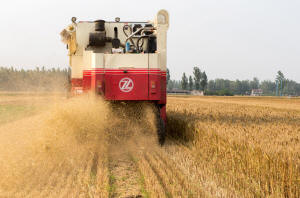Ozone harms East Asian crops, costing $63 billion a year, scientists say
 Send a link to a friend
Send a link to a friend
 [January 18, 2022]
By Gloria Dickie [January 18, 2022]
By Gloria Dickie
(Reuters) - Fossil fuel emissions aren’t
just driving climate change and worsening air quality, they’re also
hurting crop yields enough to cause some $63 billion in annual losses in
East Asia, scientists say.
With high levels of ozone pollution, China, South Korea and Japan are
seeing diminished yields in wheat, rice, and maize, according to a study
published Monday in the journal Nature Food.
China alone is losing a third of its potential wheat production and
nearly a quarter of rice yields as ozone disrupts plant growth. That has
worrying implications beyond the region, with Asia providing the
majority of the world’s rice supply.
“East Asia is one of the biggest bread baskets and rice bowls in the
world,” said lead author Zhaozhong Feng, an environmental researcher at
Nanjing University of Information Science & Technology.
Asia is also a hotspot for ozone, formed when sunlight interacts with
greenhouse gases such as nitrous oxide, carbon monoxide and volatile
organic compounds that are released by the burning of fossil fuels.
In the stratosphere, a layer of ozone protects the planet from
ultraviolet radiation. But closer to Earth’s surface, ozone can harm
plants and animals, including humans.

Feng and his colleagues used ozone monitoring data to estimate the crop
damage as costing roughly $63 billion. Previous research on the topic
has used computer simulations to assess the economic impact of ozone
pollution on crops.
Ozone “directly damages food security in China for all three crops,”
Feng said.
This is a concern for China, which is already worried about its
declining land quality. The country has to feed a fifth of the world’s
population with only 7% of its farmland.
[to top of second column]
|

A combine harvester harvests wheat on a field in Baoding, Hebei
province, China June 17, 2018. Picture taken June 17, 2018.
REUTERS/Stringer

As industry, energy and urban expansion have competed for limited land
resources, China lost some 6% of its arable land - or 7.5 million
hectares - from 2009 to 2019, according to a state land survey published
in August last year. While Beijing has since drawn a “red line” to
protect existing agricultural land, experts still anticipate the total
to fall further by 2030.
“In some parts of the world, ozone pollution is comparable to or even
worse for crops than the other big stressors of heat, drought, and
pests,” said Katrina Sharps, a spatial data analyst at the UK Centre for
Ecology and Hydrology. In a 2018 study, she and other researchers
estimated global wheat yield losses from ozone pollution totalled $24.2
billion annually between 2010 and 2012.
“It’s an under-recognized problem,” Sharps said.
Ozone levels have declined in America and Europe over the last two
decades, with the introduction of stricter air quality measures. But the
pollutant is increasing in Asia.
While the gases that contribute to ozone pollution are largely emitted
from cities, the impact is worse in rural areas where ozone forms.
Scientists said the best way to bring down ozone levels is to curb the
use of fossil fuels – the same action needed to bring down greenhouse
gas emissions causing climate change.
Without stricter emissions controls in Asia, Sharps said, “things are
going to get worse.”
(Reporting by Gloria Dickie; Additional reporting by David Stanway;
Editing by Katy Daigle and Toby Chopra)
[© 2022 Thomson Reuters. All rights
reserved.]
This material may not be published,
broadcast, rewritten or redistributed.
Thompson Reuters is solely responsible for this content. |